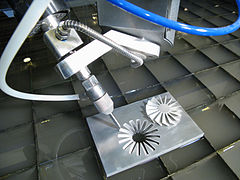- Multiaxis machining
-
Multiaxis machining is a manufacturing process, where computer numerically controlled tools that move in 4 or more ways are used to manufacture parts out of metal or other materials by milling away excess material, by water jet cutting or by laser cutting. Typical CNC tools support translation in 3 axes; multiaxis machines also support rotation around one or multiple axes.
There are now many CAM (computer aided manufacturing) software systems available to support multiaxis machining including software that can automatically convert 3-axes toolpaths into 5-axes toolpaths.[1]
Multiaxis machines offer several improvements over other CNC tools at the cost of increased complexity and price of the machine:
- Amount of work is reduced, if the piece would otherwise have to be turned manually during the machining.
- Better surface finish can be obtained by moving the tool tangentially about the surface.
- More complex parts can be manufactured, particularly parts with curved holes.
Number of axes for multiaxis machines varies from 4 to 9.[2] Each axis of movement is implemented either by moving the table (into which the workpiece is attached), or by moving the tool. The actual configuration of axes varies, therefore machines with the same number of axes can differ in the movements that can be performed.
See also
References
- ^ MCADCafé. Sescoi's WorkNC 5-Axis and Auto 5 - a competitive advantage at ALLIO.
- ^ Karlo Apro (2008). Secrets of 5-Axis Machining. Industrial Press Inc. ISBN 0-8311-3375-9.
Categories:- Machining
- Computer-aided engineering
- Metalworking stubs
Wikimedia Foundation. 2010.

